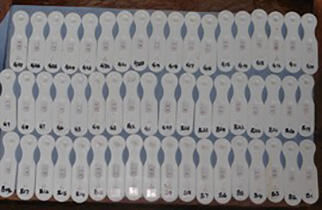
A new generation protocol, using increased mapping coverage in Northern Namibia to survey thousands of school-going children on Schistosomiasis and Soil-Transmitted Helminths, showed much improved results against low costs. It will lead to better NTD surveillance guidelines and to faster scale-up of national control.
The study, published in this month's issue of PLOS Neglected Tropical Diseases, showed that the mapping protocol bolstered field-standard microscopy results with those from commercially available rapid diagnostic tests. It increased the mapping coverage or geographical resolution to one in every four schools surveyed with minimal added cost. Results from the surveys, which included 17 896 school-going children (3–19 years of age), identified hotspots of transmission for schistosomiasis and geohelminths, particularly hookworm infection, and allowed the recommendation of constituency- and region- specific treatment regimens, as well as improvements to water, sanitation and hygiene. Furthermore, the study identified high levels of intestinal morbidity, believed to be associated with hookworm and Hymenolepis nana infections, and lower levels of urogenital pathology, associated with Schistosoma haematobium infection.
‘These outcomes show that control can be much better targeted to improve the immediate impact of mass treatment' said LSTM Professor Russell Stothard, study designer and senior author of the publication. ‘This protocol is quick, cost-effective and sensitive to budget limitations and the potential economic and logistical constraints placed on the national Ministries of Health. It comes at a time when they are about to embark on mass drug administration of praziquantel and albendazole against schistosomiasis and soil-transmitted helminths as they are about to start-up their national control programme against these diseases,’ Stothard concludes.
The publication can be seen as a significant advance on others in Africa where previous mapping of Schistosomiasis and Soil-Transmitted Helminths has been at low geographic resolution, less than 1 : 20 of surveyed schools to non-surveyed schools. This granularity often masks hotspots of disease and therefore creates incorrect treatment allocations. Using newly available Rapid Diagnostic Tests the study pioneered their use enabling a much higher mapping resolution of 1:4 and at cheaper cost. These tests were the commercially available urine-CCA test and hemastix which detect intestinal and urogenital schistosomiasis, respectively.
Mapping of Schistosomiasis and Soil-Transmitted Helminths in Namibia: The First Large-Scale Protocol to Formally Include Rapid Diagnostic Tests
José Carlos Sousa-Figueiredo, Michelle C. Stanton,Stark Katokele,Moses Arinaitwe,Moses Adriko,Lexi Balfour,Mark Reiff,Warren Lancaster,Bruce H. Noden,Ronnie Bock,J. Russell Stothard
PLOS Neglected Tropical Diseases Published: July 21, 2015 DOI: 10.1371/journal.pntd.0003831